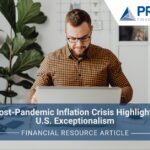New Budget Bill Includes SECURE 2.0 Act 2022 That Changes Retirement Savings
Saving for retirement might be a little easier thanks to the SECURE 2.0 Act of 2022, which will bring changes to retirement savings rules and tax breaks. The spending bill, which was passed in Congress on December 23rd, amounts to almost $1.7 trillion and includes bipartisan retirement savings legislation. The new laws known as the SECURE 2.0 Act of 2022 will change the way Americans save for retirement starting as early as January 1st.
About the SECURE 2.0 Act 2022
In 2019, Congress passed the Secure Act, which expanded access to retirement investments for employees. The SECURE 2.0 Act of 2022 seeks to build on the original act by helping people better save for retirement. Many Americans have expressed not being financially prepared for their retirement years, so the goal of the new act is to help them save more money for retirement and have the access they need to their money when they need it. The adaptation to the original bill addresses the gaps that have left some unable to properly save for the latter part of their life.
Revisions Under the SECURE 2.0 Act
There are several changes that the new bill that will alter retirement tax incentives by making changes to current retirement account rules and tax breaks. The changes are meant to encourage employees to save more for their retirement years, while giving more flexibility to retirement investment accounts.
Changes to RMDs. Currently, required minimum distributions (RMDs) must be taken from a retirement plan at age 72. The SECURE 2.0 Act will increase the RMD age to 73 starting on January 1, 2023. By 2033, the RMD age will increase to 75. The penalty for missing RMDs is being reduced from 50% to 25% of the withdrawal amount. Starting in 2024, a surviving spouse who inherits a retirement account may be able to delay RMDs.
Emergency Expense Distributions. The new legislation makes it easier for workers to withdraw funds from their retirement accounts tax-free due to personal emergencies, like a terminal illness or natural disaster. Starting in 2024, one emergency distribution up to $1,000 will be allowed each year. The emergency distribution can be taken once during the year and will not be subject to the additional 10 percent tax if a withdrawal is made early. The money must be repaid within a certain time, or you cannot take another distribution for emergency purposes for three years.
Small Incentives. The new bill will allow employers to offer small financial incentives such as low-value gift cards to increase employee participation in the company’s retirement plan. This becomes effective for the plan years after the law is passed.
Automatic Enrollment. Automatic enrollment in 401(k) employer plans does increase employee participation. With a few small business exceptions, SECURE 2.0 Act of 2022 will require participants to be automatically enrolled in 401(k) or 403 (b) plans. However, participants are able to opt-out afterward.
Catch-up Contribution Limit. Older workers will be able to save more in their retirement accounts. Those who are age 50 and over can invest an additional $7,500 to their 401(k) or 403(b) accounts as a catch-up contribution. In 2025, that amount will increase to $10,000 for those ages 60 to 63. The IRA catch-up limit will be adjusted for inflation every year, starting in 2024.
Roth 401(k) Match. Currently, if an employer offers a retirement match, it needs to be distributed into a 401(k) on a pre-tax basis under the law. The new act allows employers to offer Roth matching contributions that employees pay taxes on initially but can take out later without a tax penalty.
Employer Fund Match for Student Loan Payments. Many workers who have student debt are unable to save for retirement due to loan payments. Effective in 2024, employers can make matching contributions to employees’ retirement plans based on student loan amounts. This aims to eliminate high student loan amounts as a reason from discouraging people from saving for retirement.
National Retirement Account Registry. The SECURE 2.0 Act of 2022 will create a searchable database to help people find all of their 401(k)s. Since states operate their own versions, it can cause confusion for workers that have worked in multiple states. A national directory will be beneficial for employees that have lived and worked in different states.
Rollover 529 Funds. If a family has leftover funds in a 529 account, they have to pay a penalty to withdraw funds not being used for education. Under the new law, beneficiaries of 529 accounts can roll over up to $35,000 in a lifetime into a Roth IRA. The 529 has to be open for a minimum of 15 years in order to be able to do this.
Retirement Savings Advice
The proposed changes under the SECURE 2.0 Act of 2022 will make it easier for Americans to prepare and save for retirement and to reduce barriers to savings. Retirees will be able to use their funds more flexibly and effectively as they need. If you have any questions about the proposed new bill and how it may affect your retirement investments, please contact us.
Financial Services for Real People
Founded for the benefit of clients, Prism Capital Management is an independent Seattle and Skagit-based firm with a deep commitment to providing guidance that is free of conflicts of interest, based solely on the sum of our experience and expertise. We are committed to putting client interests first and to stewarding both wealth and well-being for those we serve. We have a singular measure of success: the results we get for our clients.
As an Investment Advisor, we have a fiduciary duty to act in YOUR best interest. From planning to investment management to advice on buying a car, we are your financial life partners.




